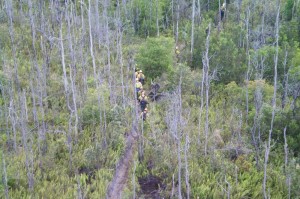 Media release | National Park Service
Media release | National Park Service
Fire Overview: Napau Fire Start Date – March 5, 2011, / (Lat/Lon: 19⁰ 22’29” x 155⁰ 7’ 25”; el. 2,450’). The Napau Fire is 80% contained. Firefighters experienced very little fire activity due to lighter than expected trade winds and 24 hours of rain; over an inch of rain has fallen on the fire area. Approximately 2,076 acres have burned with no increases in acreage. The Napau Fire is approximately seven miles southeast of the Kilauea Visitor Center, located on the east rift of Kilauea Volcano. It is a lava caused wildfire resulting from the March 5, 2011, Kamoamoa Fissure Eruption.
Strategy: The continued priority is to protect the East Rift SEA, on the north perimeter of the fire and two Kipukas, islands of vegetation, have been identified as protection priorities. The Kealakomo and Naula SEAs are on the south side of the Chain of Craters Road. The prime objective is to confine the fire to the current perimeter and acreage. Firefighter and visitor safety is always the number one objective. Although rough terrain, obscure holes, standing dead trees and other hazards exist, there have been no injuries on this fire. Due to favorable weather, firefighters were able to hold all perimeter lines of the fire and cool (cold trail) hot spots 100’ into the burn.
Values to be protected: All fires pose significant threats to the ecological health of the park, which are not fire adaptive, and will be put out. A high priority fire protection goal is the east rift Special Ecological Area (SEA), an intact lowland rain forest, which has been intensively managed to exclude invasive species and protect and restore highly valued native plant and animal communities. Protected over decades by Hawai’i Volcanoes National Park, the rain and mesic forests threatened by the spread of the Napau Fire are home to plants, birds, bugs, spiders, and bats found only in Hawai’i. They include the endangered Hawaiian bat (`ope`ape`a) Hawaiian hawk,(`io) and other uniquely Hawaiian plants and animals such as Hawaiian thrush, (`oma`o), lama and sandalwood trees, happyface spiders, carnivorous caterpillars, and Hawaiian honeycreepers (`apapane and `amakihi). National park and USGS Hawaiian Volcano Observatory (HVO) infrastructures, monitoring equipment, and other visitor features near the fire are also being protected.
Fire Resources: Hawai`i Volcanoes National Park firefighters are being augmented with NPS fire crews from Whiskeytown National Recreation Area, Olympic and Yosemite National Parks (NPS), the Pacific West Regional Office of NPS, National NPS Fire Office in Boise and the USDA Forest Service (Eldorado, Sequoia, Stanislaus and Los Padres National Forests in CA.); 50 firefighters, fire management staff and park resource advisors are committed. Fire managers will begin to release fire resources in the next few days as containment nears 100%.
Air and Smoke: There were no smoke impacts in the last 24 hours. In addition to smoke, air quality is constantly monitored in regards to sulfur dioxide emissions from volcanic activity. Fire managers will continue to coordinate fire efforts with USGS HVO scientists regarding eruption activity and air quality.
Closures: The Chain of Craters Road is re-opened. Drivers are urged to be diligent while driving, particularly near the hair-pin turn, as firefighters and fire engines are on the road.
Partners Involved: US Geological Survey Hawaiian Volcano Observatory and USDA Forest Service.

by Big Island Video News6:39 pm
on at
STORY SUMMARY
Media release | National Park Service Fire Overview: Napau Fire Start Date – March 5, 2011, / (Lat/Lon: 19⁰ 22’29” x 155⁰ 7’ 25”; el. 2,450’). The Napau Fire is 80% contained. Firefighters experienced very little fire activity due to lighter than expected trade winds and 24 hours of rain; over an inch of rain […]